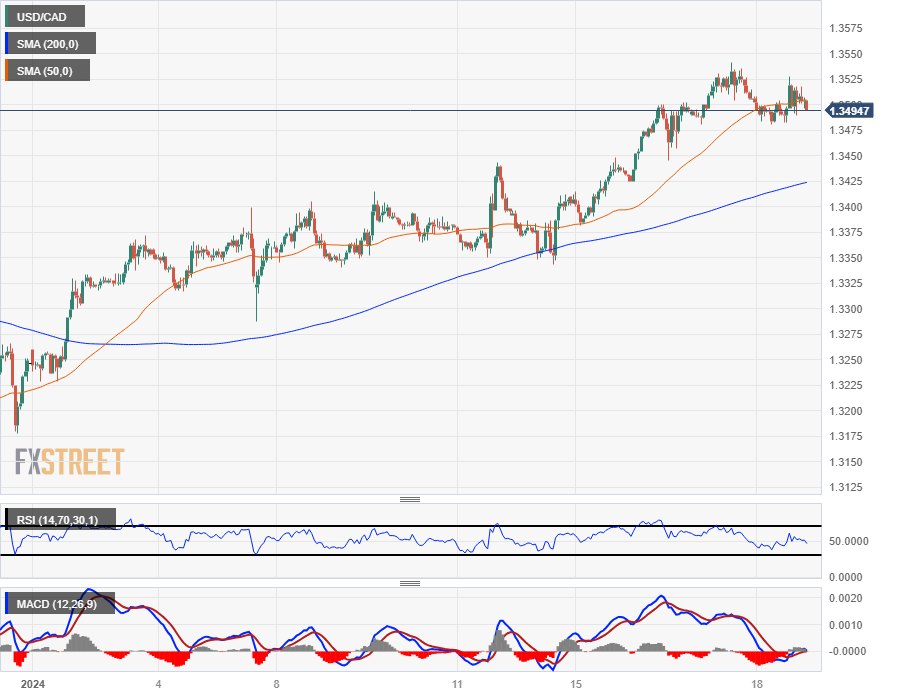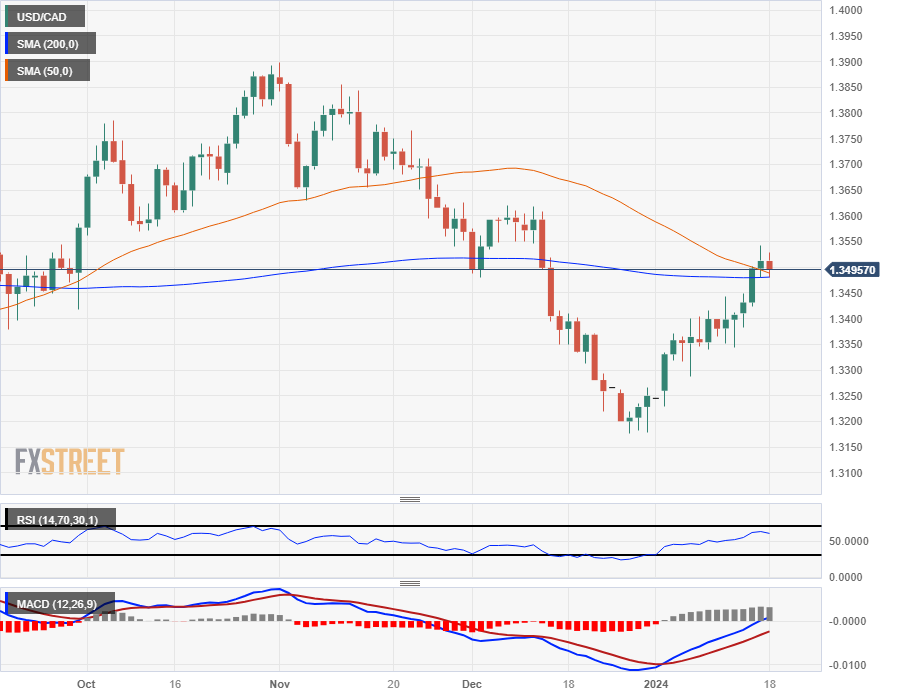- Canadian Dollar churns within near-term ranges.
- Canada sees an empty data docket for Thursday.
- Friday to wrap up the week with Canadian Retail Sales, US Michigan Consumer Sentiment.
The Canadian Dollar (CAD) pivoted around familiar levels on Thursday as broad-market flows take the driver’s seat in the back half of the trading week. The Canadian Dollar is broadly higher on the week but is still down against the outperforming US Dollar (USD) from Monday’s opening bids.
Canada will see Retail Sales figures from November on Friday, to be closely followed by the US Consumer Sentiment Index from the University of Michigan.
Daily digest market movers: Canadian Dollar trades into the middle on Thursday
- Markets continue to digest an updated rate-cut outlook as investors weigh a stubbornly strong economic outlook from the US.
- US Initial Jobless Claims printed at 187K for the week ended January 12, below the forecast of 207K and dropping away from the previous week’s 202K (revised down from 203K).
- Revisions continue to plague US data, but WoW Unemployment Claims see only minor adjustments for the time being.
- US Housing Starts also outpaced expectations, falling less than expected, and Building Permits climbing above forecasts.
- US Housing Starts added 1.46 million new units to the national housing supply, falling from the previous period’s 1.525 million (revised from 1.56 million), but falling less than the forecast 1.4265 million.
- US Building Permits climbed to 1.495 million in December, up from the previous month’s 1.467 million and above the forecast of 1.48 million.
- Markets continue to roil as investor bets of faster, deeper rate cuts from the Federal Reserve (Fed) run into the hard wall of a sturdier-than-expected US economy and uneven inflation declines.
- Fed officials continue to caution the need for slow progress as odds of a March rate cut evaporate.
Canadian Dollar price today
The table below shows the percentage change of Canadian Dollar (CAD) against listed major currencies today. Canadian Dollar was the strongest against the Swiss Franc.
| USD | EUR | GBP | CAD | AUD | JPY | NZD | CHF | |
| USD | 0.18% | -0.13% | -0.04% | -0.23% | 0.07% | 0.11% | 0.48% | |
| EUR | -0.18% | -0.33% | -0.23% | -0.43% | -0.10% | -0.12% | 0.31% | |
| GBP | 0.15% | 0.34% | 0.11% | -0.09% | 0.23% | 0.21% | 0.64% | |
| CAD | 0.04% | 0.24% | -0.09% | -0.19% | 0.12% | 0.11% | 0.54% | |
| AUD | 0.23% | 0.43% | 0.10% | 0.19% | 0.29% | 0.29% | 0.74% | |
| JPY | -0.06% | 0.12% | -0.21% | -0.11% | -0.30% | -0.01% | 0.42% | |
| NZD | -0.02% | 0.14% | -0.22% | -0.08% | -0.26% | -0.06% | 0.45% | |
| CHF | -0.47% | -0.30% | -0.62% | -0.52% | -0.70% | -0.41% | -0.42% |
The heat map shows percentage changes of major currencies against each other. The base currency is picked from the left column, while the quote currency is picked from the top row. For example, if you pick the Euro from the left column and move along the horizontal line to the Japanese Yen, the percentage change displayed in the box will represent EUR (base)/JPY (quote).
Technical Analysis: Canadian Dollar avoids further losses, but US Dollar remains strong
The Canadian Dollar (CAD) is getting bolstered by declines in the Euro (EUR and the Swiss Franc (CHF), up around 0.2% and 0.4%, respectively. The Loonie is relatively flat across the rest of the major currency board, within a fifth of a percent of the US Dollar, Pound Sterling (GBP), Australian Dollar (AUD), and the Japanese Yen (JPY).
The US Dollar saw an early rise on Thursday, dragging the USD/CAD toward 1.3530 before markets balked on momentum and pulled back into the midrange, leaving the pair stuck in intraday consolidation near 1.3500.
After a 2.4% recovery from December’s bottom near 1.3177 the USD/CAD is facing a congestion zone as the 50-day and 200-day Simple Moving Averages (SMA) consolidate near 1.3500.
USD/CAD Hourly Chart
USD/CAD Daily Chart
Canadian Dollar FAQs
What key factors drive the Canadian Dollar?
The key factors driving the Canadian Dollar (CAD) are the level of interest rates set by the Bank of Canada (BoC), the price of Oil, Canada’s largest export, the health of its economy, inflation and the Trade Balance, which is the difference between the value of Canada’s exports versus its imports. Other factors include market sentiment – whether investors are taking on more risky assets (risk-on) or seeking safe-havens (risk-off) – with risk-on being CAD-positive. As its largest trading partner, the health of the US economy is also a key factor influencing the Canadian Dollar.
How do the decisions of the Bank of Canada impact the Canadian Dollar?
The Bank of Canada (BoC) has a significant influence on the Canadian Dollar by setting the level of interest rates that banks can lend to one another. This influences the level of interest rates for everyone. The main goal of the BoC is to maintain inflation at 1-3% by adjusting interest rates up or down. Relatively higher interest rates tend to be positive for the CAD. The Bank of Canada can also use quantitative easing and tightening to influence credit conditions, with the former CAD-negative and the latter CAD-positive.
How does the price of Oil impact the Canadian Dollar?
The price of Oil is a key factor impacting the value of the Canadian Dollar. Petroleum is Canada’s biggest export, so Oil price tends to have an immediate impact on the CAD value. Generally, if Oil price rises CAD also goes up, as aggregate demand for the currency increases. The opposite is the case if the price of Oil falls. Higher Oil prices also tend to result in a greater likelihood of a positive Trade Balance, which is also supportive of the CAD.
How does inflation data impact the value of the Canadian Dollar?
While inflation had always traditionally been thought of as a negative factor for a currency since it lowers the value of money, the opposite has actually been the case in modern times with the relaxation of cross-border capital controls. Higher inflation tends to lead central banks to put up interest rates which attracts more capital inflows from global investors seeking a lucrative place to keep their money. This increases demand for the local currency, which in Canada’s case is the Canadian Dollar.
How does economic data influence the value of the Canadian Dollar?
Macroeconomic data releases gauge the health of the economy and can have an impact on the Canadian Dollar. Indicators such as GDP, Manufacturing and Services PMIs, employment, and consumer sentiment surveys can all influence the direction of the CAD. A strong economy is good for the Canadian Dollar. Not only does it attract more foreign investment but it may encourage the Bank of Canada to put up interest rates, leading to a stronger currency. If economic data is weak, however, the CAD is likely to fall.
Information on these pages contains forward-looking statements that involve risks and uncertainties. Markets and instruments profiled on this page are for informational purposes only and should not in any way come across as a recommendation to buy or sell in these assets. You should do your own thorough research before making any investment decisions. FXStreet does not in any way guarantee that this information is free from mistakes, errors, or material misstatements. It also does not guarantee that this information is of a timely nature. Investing in Open Markets involves a great deal of risk, including the loss of all or a portion of your investment, as well as emotional distress. All risks, losses and costs associated with investing, including total loss of principal, are your responsibility. The views and opinions expressed in this article are those of the authors and do not necessarily reflect the official policy or position of FXStreet nor its advertisers. The author will not be held responsible for information that is found at the end of links posted on this page.
If not otherwise explicitly mentioned in the body of the article, at the time of writing, the author has no position in any stock mentioned in this article and no business relationship with any company mentioned. The author has not received compensation for writing this article, other than from FXStreet.
FXStreet and the author do not provide personalized recommendations. The author makes no representations as to the accuracy, completeness, or suitability of this information. FXStreet and the author will not be liable for any errors, omissions or any losses, injuries or damages arising from this information and its display or use. Errors and omissions excepted.
The author and FXStreet are not registered investment advisors and nothing in this article is intended to be investment advice.
Recommended content
Editors’ Picks

EUR/USD bounces off lows, retests 1.1370
Following an early drop to the vicinity of 1.1310, EUR/USD now manages to regain pace and retargets the 1.1370-1.1380 band on the back of a tepid knee-jerk in the US Dollar, always amid growing optimism over a potential de-escalation in the US-China trade war.

GBP/USD trades slightly on the defensive in the low-1.3300s
GBP/USD remains under a mild selling pressure just above 1.3300 on Friday, despite firmer-than-expected UK Retail Sales. The pair is weighed down by a renewed buying interest in the Greenback, bolstered by fresh headlines suggesting a softening in the rhetoric surrounding the US-China trade conflict.

Gold remains offered below $3,300
Gold reversed Thursday’s rebound and slipped toward the $3,260 area per troy ounce at the end of the week in response to further improvement in the market sentiment, which was in turn underpinned by hopes of positive developments around the US-China trade crisis.

Ethereum: Accumulation addresses grab 1.11 million ETH as bullish momentum rises
Ethereum saw a 1% decline on Friday as sellers dominated exchange activity in the past 24 hours. Despite the recent selling, increased inflows into accumulation addresses and declining net taker volume show a gradual return of bullish momentum.

Week ahead: US GDP, inflation and jobs in focus amid tariff mess – BoJ meets
Barrage of US data to shed light on US economy as tariff war heats up. GDP, PCE inflation and nonfarm payrolls reports to headline the week. Bank of Japan to hold rates but may downgrade growth outlook. Eurozone and Australian CPI also on the agenda, Canadians go to the polls.

The Best brokers to trade EUR/USD
SPONSORED Discover the top brokers for trading EUR/USD in 2025. Our list features brokers with competitive spreads, fast execution, and powerful platforms. Whether you're a beginner or an expert, find the right partner to navigate the dynamic Forex market.



